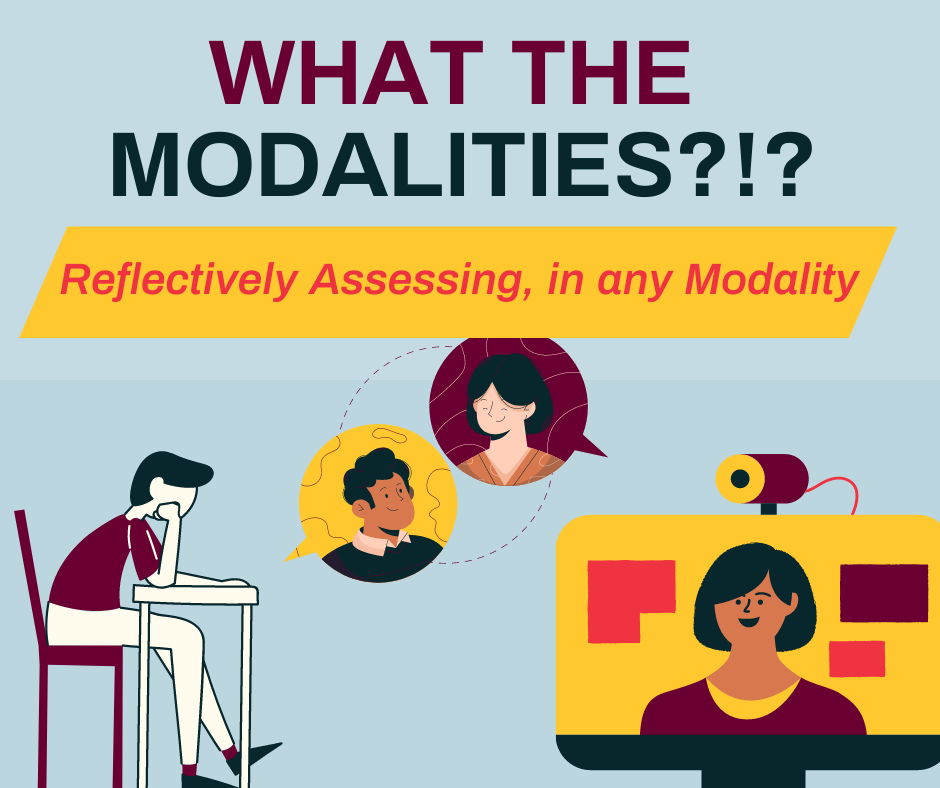“We know our disciplines well, but now it is time to consider how to translate our practices to the many “spaces” we find ourselves (and our learners) in so that we can foster learning and prepare our students for a competitive, global workforce” (MTMC, Module 1).
To support CMU instructors on your continued journey, over the next 2 weeks, we will explore what effective teaching and learning looks like in these new and diverse settings as we share practical information and valuable insights from our Multi-Modal Teaching Methods Certification (or MTMC) faculty development opportunity.
Reflectively Assessing, in any Modality
Think back to your own past learning experiences, to when your teacher said something like, “If you have any questions, let me know.” We’ve all heard (and likely said) this phrase before, but does this statement authentically query student understanding? Or do we assume “no news is good news” (until we sit down to assess student work)? Now, as an educator navigating higher education post-pandemic, how has measuring student understanding changed since 2020?
In our quest to enhance instruction and communication techniques in modern learning spaces, we must also contemplate how we gauge learner knowledge and how our “assessments” inform our instructional planning and activities. Miyagawa and Perdue (2020) reflect on the pandemic-driven transition to online and remote teaching and assessment and ask, “…why are we testing students in this way? One instructor concluded that it’s because we have been doing it the same way for 50 years” (para. 20). Their study offers exciting insight: “A number of instructors reported reducing or eliminating quizzes and exams, and instead, creating more group projects and oral assessments for measuring learning outcomes. The instructors developed more opportunities to check in with their students in one-on-one meetings and found that was productive both for building community and for gauging the students’ learning” (para. 23).
How can assessment techniques be effectively accomplished in a multi-modal course? Teaching in multi-modal settings can offer flexibility for yourself and your students, but implementing assessments that authentically measure student learning (and transfer seamlessly across modalities) can also be quite overwhelming. As you navigate this reflective process, consider your current assessments methods. Miyagawa and Perdue (2020), encourage you to reflect on the “why” behind the methods used to assess student learning in our courses and explore alternatives to the typically “traditional” types when possible and appropriate.
What does that mean? When assessing within any instructional modality, implementation is often limited to simply measuring what students know. After all, this is what assessments are intended to do in our courses. However, this sole application leaves a significant amount of our instructional potential untapped. This untapped potential is particularly valuable in remote, virtual, and online spaces and face-to-face traditional learning environments.
To harness the full potential of assessments in our course(s), we must recognize the role assessments play. Instead of approaching our assessments from “How can I measure what students know?”, consider asking, “How can students demonstrate their learning?” The easily overlooked, often imperceptible difference between these two viewpoints illustrates the distinction. Distinguishing between these two viewpoints might help illustrate the distinction between these perspectives. The first approach assumes that the learning is complete, the goal of that assessment is strictly for evaluation, and that the role of the students is more passive than the instructor (who is doing the measuring). However, the second approach implies that students are active in demonstrating knowledge and, perhaps even more important, that their learning is continuously ongoing, during and even after the assessment is completed.
A quick and easy way to apply this filter and approach assessments (in any modality) from the second perspective is to use assessments in your course(s) as a learning tool and as an instructional tool, instead of only as a “measurement.” When you do this, not only do you gain more accurate measurements of student learning, but you can also have more confidence that you are making the most out of assessments in your course.
Wondering what this looks like? What comes next? Read our blog article “Say Yes to Non-Traditional Assessments, check out next week’s CIS newsletter, enroll in the MTMC training shell, or send us an email.
Reference:
Miyagawa, S. & Perdue, M. (2020). A renewed focus on the practice of teaching. Inside Higher Ed. Retrieved from https://www.insidehighered.com/advice/2020/11/11/switching-online-teaching-during-pandemic-may-fundamentally-change-how-faculty

